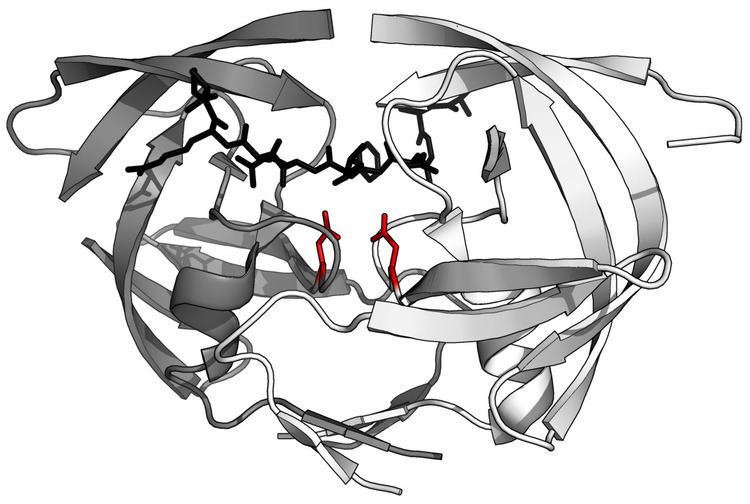EC number 3.4.23.16 ExPASy NiceZyme view | CAS number 144114-21-6 | |
 | ||
HIV-1 protease is a retroviral aspartyl protease (retropepsin) that is essential for the life-cycle of HIV, the retrovirus that causes AIDS. HIV protease cleaves newly synthesized polyproteins (namely, Gag and Gag-Pol) at the appropriate places to create the mature protein components of an infectious HIV virion. Without effective HIV protease, HIV virions remain uninfectious. Thus, mutation of HIV protease's active site or inhibition of its activity disrupts HIV’s ability to replicate and infect additional cells, making HIV protease inhibition the subject of considerable pharmaceutical research.
Contents
Structure and function
HIV protease's protein structure has been investigated using X-ray crystallography. It exists as a homodimer, with each subunit made up of 99 amino acids.
The active site lies between the identical subunits and has the characteristic Asp-Thr-Gly (Asp25, Thr26 and Gly27) sequence common to aspartic proteases. The two Asp25 residues (one from each chain) act as the catalytic residues. According to the mechanism for HIV protease protein cleavage proposed by Mariusz Jaskolski and colleagues, water acts as a nucleophile, which acts in simultaneous conjunction with a well-placed aspartic acid to hydrolyze the scissile peptide bond. Additionally, HIV protease has two molecular "flaps" which move a distance of up to 7 Å when the enzyme becomes associated with a substrate.
HIV-1 protease as a drug target
With its integral role in HIV replication, HIV protease has been a prime target for drug therapy. HIV protease inhibitors work by specifically binding to the active site by mimicking the tetrahedral intermediate of its substrate and essentially becoming “stuck,” disabling the enzyme. After assembly and budding, viral particles lacking active protease cannot mature into infectious virions. Several protease inhibitors have been licensed for HIV therapy.
However, due to the high mutation rates of retroviruses, and considering that changes to a few amino acids within HIV protease can render it much less visible to an inhibitor, the active site of this enzyme can change rapidly when under the selective pressure of replication-inhibiting drugs.
One approach to minimizing the development of drug-resistance in HIV is to administer a combination of drugs which inhibit several key aspects of the HIV replication cycle simultaneously, rather than one drug at a time. Other drug therapy targets include reverse transcriptase, virus attachment, membrane fusion, cDNA integration and virion assembly.
